Chuck-will’s-widow (Antrostomus carolinensis) is a good-sized mottled brown and buff nightbird with a large, flat head, and a long tail.
This nightjar species is an uncommon bird of dry pine and oak woodlands in the southeastern USA. It also ranges north to southern Iowa and Long Island, New York.
If you are out at night in the southeastern USA and see a large, mottled brown bird perched on a post, you may have found a Chuck-will’s-widow! Listen for “Chuck-will’s-widows” singing their name on humid, southern summer nights.
Have you wondered where Chuck-will’s-widows live? Learn all about this unique bird in this article!
On this page
Identification
Chuck-will’s-widow is a big, fluffy nightjar with long, rather pointed wings, and a longish tail. It has a large head with fine black streaks on a flat crown, big, dark brown eyes, and a red-brown face.
Both sexes of this nightjar species look very similar and are one foot long, have a two-foot, two-inch wingspan, and weigh 4.2 ounces. They also have a brown or red-brown throat bordered by a pale line on each side, and a pale shoulder bordered with black spots.
This species is mottled brown below with fine barring, has a paler brown undertail, and black barring on its red-brown and gray wings. It also has buff on the underside of its tail. The only way to separate males from females and recognize young Chuck-will’s-widows is by looking at the details in their tails.
When they spread their tails, males show some white while females only have buff tips on the corners of their tail.
Chuck-will’s-widows always show the key characteristics mentioned above but come in two main color morphs. They can be mostly red-brown with some gray highlights, or, be gray and brown with a few red-brown highlights.
At dusk and dawn, males sing their name over and over, “Chuck-will’s-widow!”.
Food
Chuck-will’s-widows mostly feed on large insects but they can also catch small birds and bats. On occasion, when they are molting and can’t fly as well, this nightjar also feeds on small frogs!
This species eats lots of big flying insects and may depend on them to maintain healthy populations. They eat big long-horned beetles, June Beetles, other types of beetles, and lots of medium and large moths. As long as the insect is flying, they can also catch other types of bugs.
Once in a while, Chuck-will’s-widows also eat small bats and birds. Some of the species they have been documented eating include Hooded Warbler, Carolina Wren, and Common Yellowthroat!
This nightjar species only catches these small vertebrates when the chance presents itself, perhaps especially during migration.
Whether feeding on bats, small birds, or lots of big bugs, the Chuck-will’s-widow catches most of its prey in flight. They typically wait on a perch or a low branch, and then fly up to snatch prey with their mouth. Chuck-will’s-widows can also glide and fly low over the ground to find and catch flying insects.
Although they live in wooded habitats, these big nocturnal birds usually hunt at the edge of open or semi-open areas.
Nesting and Eggs
Chuck-will’s-widows arrive back to their breeding grounds in late March to April and form pairs just a week or so after. Instead of building a nest, the female Chuck-will’s-widow lays one to four eggs (usually just two) directly on the ground.
She lays her eggs on pine needles or other types of leaf litter, and can also lay them on bare ground. The mother bird usually picks a spot beneath some low vegetation that will help to hide her and the baby birds.
Although Chuck-will’s-widows can nest in all sorts of places, they may prefer nesting under cedars or pines. This species might also prefer to nest near old roads or other spots with good feeding opportunities.
Their eggs are pale gray with some dark markings, are 1.5 inches long, and are incubated by both sexes for 20 days. After hatching, the young birds are covered in soft down and can move a little but stay in the nesting spot.
Their mother feeds them at the nest for the next 16 days. By that time, the nestlings start to fly but stay at or near their nest for another two weeks. During that time, they continue to be fed by their mother until they become independent.
Current Situation
The Chuck-will’s-widow is an uncommon species that breeds in woodland habitats from parts of Iowa, Indiana, and Long Island, New York south to Texas and Florida. They winter in forest and edge habitats from southern Texas and Florida to Colombia.
This species is listed as Near Threatened in the IUCN Red List and has become uncommon in many parts of its range.
Although Chuck-will’s-widows are believed to have a large population of 5 million plus birds, they have been steadily declining for several years. Some studies have estimated the decline to be 24% percent in just 12 years! Based on this steep drop in numbers, this species is listed as Near Threatened.
The reasons for the decline in Chuck-will’s-widows aren’t well known. However, several factors are probably involved, including habitat degradation and birds being susceptible to being hit by vehicles. Their drop in numbers is also probably related to large-scape decreases in the insects that they feed on.
Facts
- The Chuck-will’s-widow has a very small tip on its bill. This makes it look like it has a small mouth when the truth is just the opposite. When they open their mouth, it is large enough to catch and swallow warblers and bats whole!
- Once in a while, this species is seen sitting under street lamps. In such situations, they can perch on the ground and feed on insects and frogs attracted to the light.
- Chuck-will’s-widows have long bristles around the edge of their beak. These “rictal bristles” help them to funnel insects into their mouth. They might also serve some sensory purpose.
- This species regularly eats small stones. Like several other birds, it does this to help break up hard beetle carapaces and other tough insect parts.
- When nesting, a female Chuck-will’s-widow won’t leave her eggs until the last possible moment. This is because she uses her own body as excellent camouflage to keep the eggs hidden. This makes nesting Chuck-will’s-widows very hard to find and is why they won’t fly off their nest unless you nearly step on them.
Similar Species
The Chuck-will’s-widow is distinctive but is easily confused with a few other species. However, they can be recognized by getting a good look at the right field marks.
Eastern Whip-poor-will
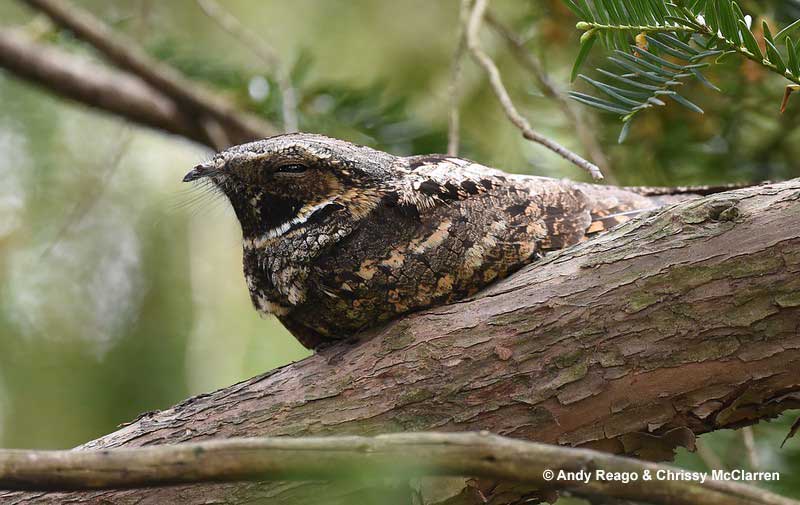
The related Eastern Whip-poor-will is pretty similar. It also has mottled gray and brown plumage, a pale mark on its shoulder, and can live in some of the same areas.
However, the Chuck-will’s-widow is bigger and has longer, more pointed wings. It also has fine streaks on its larger, flatter head, while whip-poor-wills have a dark stripe on the center of their crown. Whip-poor-wills can also have large white marks on their tail, and a plain buff undertail.
Common Pauraque
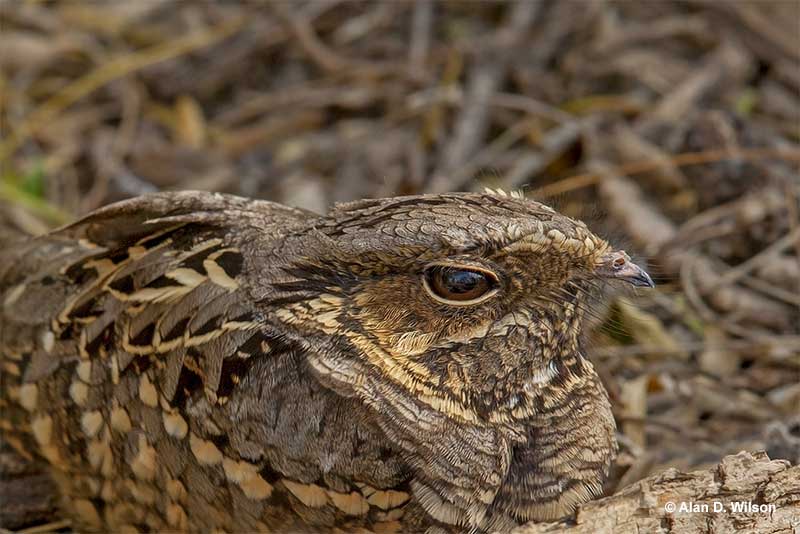
In southern Texas, the Common Pauraque can occur with wintering Chuck-will’s-widows. Similar to the Chuck-will’s-widow, the pauraque also has a long tail, long wings, and a red-brown face. However, it does not have dark streaking on a flat crown, is paler below, and has a buff or white patch on each wing.
Common Nighthawk
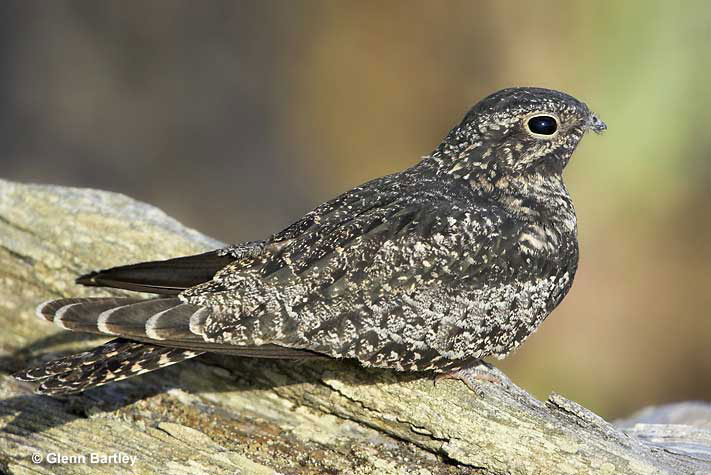
Although shaped quite differently, this species also has similar mottled gray and brown plumage. However, Common Nighthawks have a forked tail and long, pointed wings with a white patch near the wing tips. They also hawk insects high overhead and make a “peent” call.
Frequently Asked Questions
Are Chuck Will’s Widows rare?
No, Chuck-will’s-widows are not rare. However, they have declined in many areas and their nocturnal habits can make them generally tough to see.
Why is it called a Chuck Will’s Widow?
It is called a Chuck-will’s-widow because of its song. At night, this bird sounds like it is saying its own name as it whistles, over and over, “Chuck-will’s-widow …Chuck-will’s-widow…”.
What’s the difference between a Chuck Will’s Widow and a Whip-poor-will?
The difference between a Chuck-will’s-widow and a Whip-poor-will is that the Chuck-will’s-widow is larger, has a bigger, flatter head, and lacks a buff undertail. The Whip-poor-will also sounds like it is saying its name, while the Chuck-will’s-widow sings, “Chuck-will’s-widow!”.
What does a Chuck Will’s Widow eat?
A Chuck-will’s-widow eats big flying beetles and moths, and occasionally catches small birds and bats.
How big is Chuck Will’s Widow?
A Chuck-will’s-widow is about a foot long and has a 26 inch wingspan.

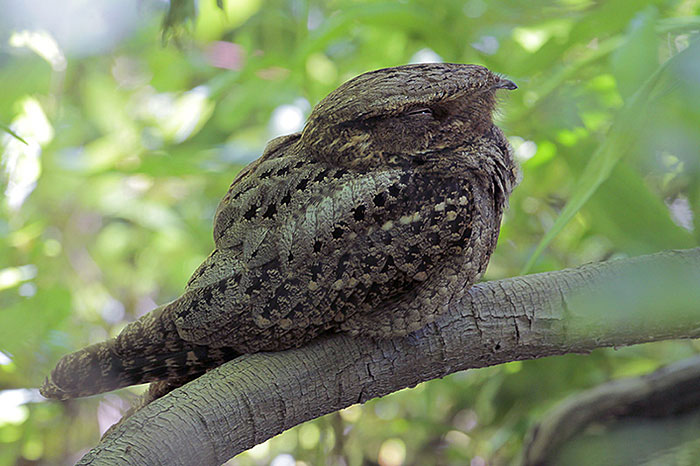

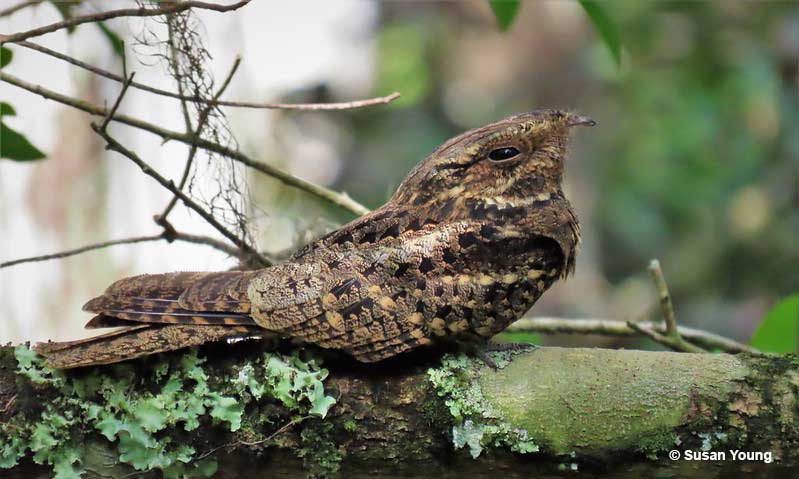
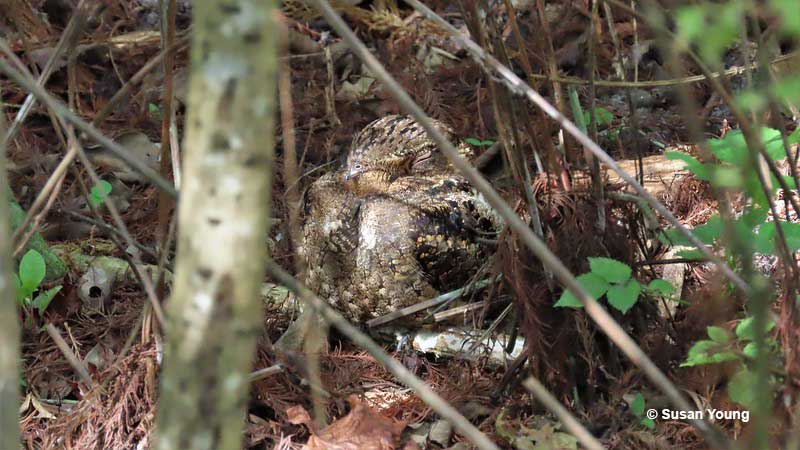
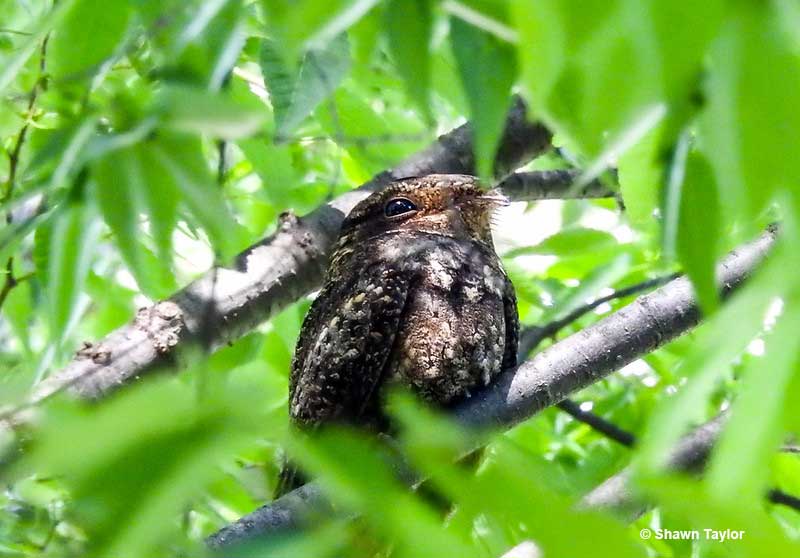
Diane
Tuesday 19th of March 2024
We have a chuck wills widow in our warehouse garage for 2 days and we’ ve opened both bay doors all day but the bird will not fly out! It keeps just flying around or perching, how can we get it out? We dont want it to starve.
Patrick O'Donnell
Saturday 23rd of March 2024
@Diane- That's a tricky situation alright. One idea is to open the doors just after it gets dark. That might encourage it to fly out. Another idea is to call a local wildlife rehabilitator. They should know how to catch and take care of the bird.